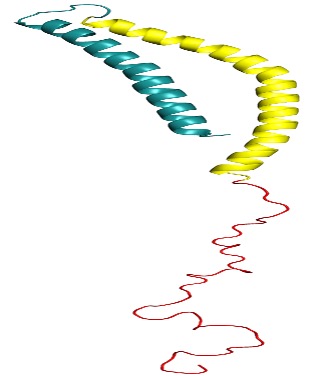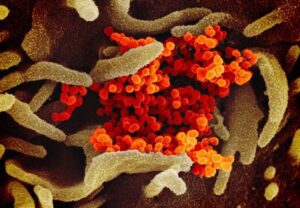
Figure 1: 3D structure of alpha-synuclein protein. Mutations in alpha-synuclein that alter its structure have been linked to Parkinson’s disease.
Source: Wikimedia Commons
Parkinson’s disease affects around 1 million individuals in the US.¹ It is a neurodegenerative disease typically characterized by tremors, and it severely impacts motor functions including movement, speech, and balance.² Despite its prevalence, individuals are usually diagnosed late into its pathogenesis, after obvious symptoms appear. For this reason, researchers have strived to determine earlier screening and tracking methods for Parkinson’s disease.³
The alpha-synuclein (ɑ-synuclein) protein is linked to several neurodegenerative diseases, including Parkinson’s disease. In a healthy individual, it is a presynaptic neural protein abundant in the human brain that stays near neuron terminals.⁴ In a person with Parkinson’s disease, ɑ-synuclein protein forms aggregates that contribute to Lewy bodies and Lewy neurites, the hallmarks of Parkinson’s disease. The main challenges that prevented ɑ-synuclein from being a helpful clinical marker include a lack of a tracer with sufficiently high affinity and a lack of specificity to the fibrils of ɑ-synuclein.³ After recent developments in determining the structure of ɑ-synuclein, researchers in the labs of E. James Petersson, Robert Mach, and Virginia Lee sought to change that by using in silico (computationally based) screening. This method relied on utilizing exemplars to seek a molecule that could be used as an imaging probe for positron emission tomography (PET).⁵
First, the researchers identified potential compounds by developing an ultrahigh throughput in silico screening method using exemplars (pseudo-ligands), which bind perfectly with ɑ-synuclein. After using their method to sift through seven million candidate molecules, they examined the binding sites and structure-activity interactions using photocrosslinking to the handful of potential molecules. Photocrosslinking is the process of inducing covalent bonds between macromolecules using electromagnetic radiation. Then, comparing their exemplars to available molecules, they developed several molecules with high levels of affinity and specificity for ɑ-synuclein fibrils and specificity for ɑ-synuclein fibrils over amyloid fibrils, which are indicators of Alzheimer’s disease. Finally, the researchers tested the potential of each molecule as an imaging probe by observing its binding to ɑ-synuclein-enriched homogenates from mouse brain tissue. They discovered two molecules that had very high binding affinities to ɑ-synuclein that could potentially be used in screening and tracing Parkinson’s disease. Their novel method in searching for an imaging probe molecule was revolutionary in its efficient screening techniques. This approach changes the way that scientists typically discover probes and will be applied to other neurodegenerative diseases.³
The application of computational methods in medicine illustrates the way multiple fields intersect and build on each other to generate new discoveries. Although much is still unknown about Parkinson’s disease and other neurodegenerative diseases, more interdisciplinary research could greatly improve future knowledge, treatment, and care for patients with neurodegenerative diseases.
References
Marras, C., Beck, J. C., Bower, J. H., Roberts, E., Ritz, B., Ross, G. W. ., Abbott, R. D., Savica, R., Van Den Eeden, S. K., Willis, A. W., & Tanner, C. (2018). Prevalence of Parkinson’s disease across North America. npj Parkinson’s Disease, 4(21). https://doi.org/10.1038/s41531-018-0058-0
Parkinson’s disease. (2020, August 07). Mayo Clinic. Retrieved September 29, 2020 from https://www.mayoclinic.org/diseases-conditions/parkinsons-disease/symptoms-causes/syc-20376055
Ferrie, J. J., Lengyel-Zhand, Z., Janssen, B., Lougee, M. G., Giannakoulias, S., Hsieh, C.-J., Pagar, V. V., Weng, C.-C., Xu, H., Graham, T. J. A., Lee, V. M.-Y., Mach, R. H., & Petersson, E. J. (2020). Identification of a nanomolar affinity α-synuclein fibril imaging probe by ultra-high throughput in silico screening. Chemical Science. https://doi.org/10.1039/D0SC02159H
Stefanis, L. (2012). α-Synuclein in Parkinson’s Disease. Cold Spring Harbor Perspectives in Medicine, 2(2). https://doi.org/10.1101/cshperspect.a009399
University of Pennsylvania. (2020, September 21). Researchers discover new molecules for tracking Parkinson’s disease. ScienceDaily. Retrieved September 29, 2020 from www.sciencedaily.com/releases/2020/09/200921112438.htm
Related Posts
Human Endogenous Retroviruses Might Unlock a New Field of Neurodegenerative Disease Research
Figure 1: Researchers have found viral genetic materials within the...
Read MoreThe “Old Friends” Hypothesis and the COVID-19 Pandemic
Authors: Sakeena Badrane1, Vivek Babu2, Sanah Handu1 1University of Pittsburgh,...
Read MoreAn International Team of Researchers Just Solved One of the Biggest Mysteries About the Human Heart
Figure 1: The heart is one of the most complex...
Read MoreMiranda Yu



